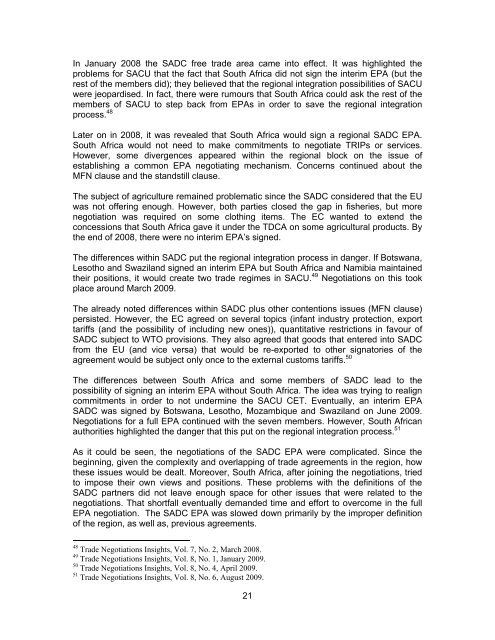EPA Review Annex Documents - DFID
EPA Review Annex Documents - DFID
EPA Review Annex Documents - DFID
Create successful ePaper yourself
Turn your PDF publications into a flip-book with our unique Google optimized e-Paper software.
In January 2008 the SADC free trade area came into effect. It was highlighted the<br />
problems for SACU that the fact that South Africa did not sign the interim <strong>EPA</strong> (but the<br />
rest of the members did); they believed that the regional integration possibilities of SACU<br />
were jeopardised. In fact, there were rumours that South Africa could ask the rest of the<br />
members of SACU to step back from <strong>EPA</strong>s in order to save the regional integration<br />
process. 48<br />
Later on in 2008, it was revealed that South Africa would sign a regional SADC <strong>EPA</strong>.<br />
South Africa would not need to make commitments to negotiate TRIPs or services.<br />
However, some divergences appeared within the regional block on the issue of<br />
establishing a common <strong>EPA</strong> negotiating mechanism. Concerns continued about the<br />
MFN clause and the standstill clause.<br />
The subject of agriculture remained problematic since the SADC considered that the EU<br />
was not offering enough. However, both parties closed the gap in fisheries, but more<br />
negotiation was required on some clothing items. The EC wanted to extend the<br />
concessions that South Africa gave it under the TDCA on some agricultural products. By<br />
the end of 2008, there were no interim <strong>EPA</strong>’s signed.<br />
The differences within SADC put the regional integration process in danger. If Botswana,<br />
Lesotho and Swaziland signed an interim <strong>EPA</strong> but South Africa and Namibia maintained<br />
their positions, it would create two trade regimes in SACU. 49 Negotiations on this took<br />
place around March 2009.<br />
The already noted differences within SADC plus other contentions issues (MFN clause)<br />
persisted. However, the EC agreed on several topics (infant industry protection, export<br />
tariffs (and the possibility of including new ones)), quantitative restrictions in favour of<br />
SADC subject to WTO provisions. They also agreed that goods that entered into SADC<br />
from the EU (and vice versa) that would be re-exported to other signatories of the<br />
agreement would be subject only once to the external customs tariffs. 50<br />
The differences between South Africa and some members of SADC lead to the<br />
possibility of signing an interim <strong>EPA</strong> without South Africa. The idea was trying to realign<br />
commitments in order to not undermine the SACU CET. Eventually, an interim <strong>EPA</strong><br />
SADC was signed by Botswana, Lesotho, Mozambique and Swaziland on June 2009.<br />
Negotiations for a full <strong>EPA</strong> continued with the seven members. However, South African<br />
authorities highlighted the danger that this put on the regional integration process. 51<br />
As it could be seen, the negotiations of the SADC <strong>EPA</strong> were complicated. Since the<br />
beginning, given the complexity and overlapping of trade agreements in the region, how<br />
these issues would be dealt. Moreover, South Africa, after joining the negotiations, tried<br />
to impose their own views and positions. These problems with the definitions of the<br />
SADC partners did not leave enough space for other issues that were related to the<br />
negotiations. That shortfall eventually demanded time and effort to overcome in the full<br />
<strong>EPA</strong> negotiation. The SADC <strong>EPA</strong> was slowed down primarily by the improper definition<br />
of the region, as well as, previous agreements.<br />
48 Trade Negotiations Insights, Vol. 7, No. 2, March 2008.<br />
49 Trade Negotiations Insights, Vol. 8, No. 1, January 2009.<br />
50 Trade Negotiations Insights, Vol. 8, No. 4, April 2009.<br />
51 Trade Negotiations Insights, Vol. 8, No. 6, August 2009.<br />
21
















